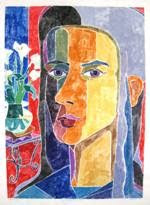
Karl Kasten, an artist I met and became acquainted with just recently, passed away a couple of weeks ago, and I am remembering how kind and generous he was during a visit I made to his house. First off, Karl was more than 50 years my senior, about the same age my grandfather would have been if alive today. My chance encounter came when I phoned a friend of a friend and said, "I would like to just meet him." I was late to our lunch date, where his wife, Georgina, had made crepes, and we shared some white wine. I felt special being amongst new friends.
He showed me around his house, which was difficult to walk through quickly because every square inch of wall space had been covered by Karl and Georgina's collection of prints and paintings, collected over their lifetime. Almost every item in their home seemed like a museum object, and I wanted to spend time with each object to appreaciate its value and beauty. We visited his studio where I had a good look around, and Karl showed me what he was working on in prints, and his paintings. He was kind enough to share many stories about his great teachers in art like Worth Ryder, Chiura Obata, and Hans Hoffmann with me.
Our time was cut short, as Karl needed his rest. Karl recently published a memoir titled "Foghorns and Peacocks," which highlights his experiences as a Bay Area artist and all his special moments with some of the great artists that passed through the San Francisco Area. Before I left he handed me a signed and dedicated copy of his book. I am proud to have my single moment with Karl and understand why he was so loved.
for more information on Karl Kasten:
http://www.universityofcalifornia.edu/news/article/23372
http://en.wikipedia.org/wiki/Karl_Kasten





